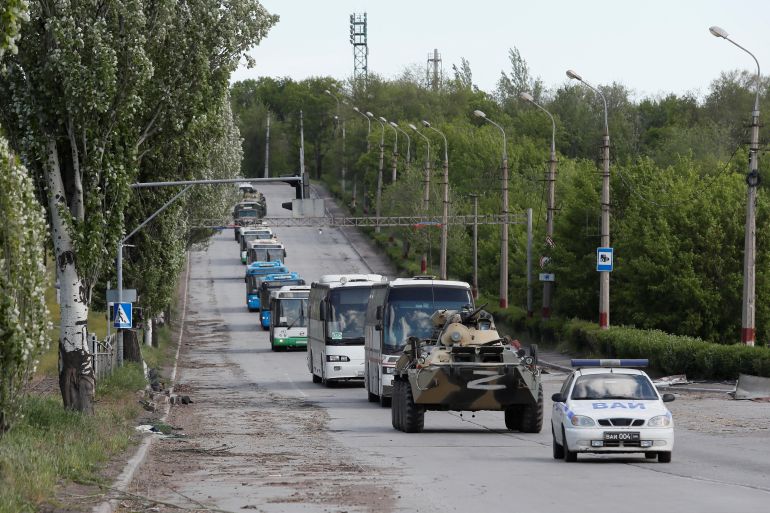Fate of hundreds of Ukrainian fighters uncertain after surrender
Ukrainian official says Kyiv pursuing a prisoner exchange as Russian siege of steel plant draws to a close.

The fate of Ukrainian defenders of Mariupol’s Azovstal steel plant remained uncertain on Tuesday after hundreds surrendered and were transported to Russian-controlled territory.
Russia said on Tuesday 265 Ukrainian fighters had surrendered from a besieged final stronghold in the steel plant, hours after Ukrainian President Volodymyr Zelenskyy said the mission to defend the facility was over and several fighters had been moved to Russian territory.
Keep reading
list of 3 itemsUkraine war: Global fertiliser crunch pressures Brazil’s Amazon
More than 260 Ukraine troops evacuated from Mariupol plant: Kyiv
Russia’s defence minister said that of those who surrendered, 51 were seriously wounded and taken to a hospital in Novoazovsk in the Russian-backed breakaway Donetsk region. Their fate remained uncertain.
While Ukrainian Deputy Defence Minister Hanna Malyar said “an exchange procedure will take place for their return home”, Zelenskyy cautioned that “the work of bringing the boys home … needs delicacy and time.”
The speaker of Russia’s parliament said it will consider banning the exchange of Russian prisoners of war for captured members of Ukraine’s Azov regiment.
Vyacheslav Volodin, speaker of the State Duma, said its members were “Nazi criminals” who should not be included in prisoner exchanges.
“They are war criminals and we must do everything to bring them to justice,” he said.
The Duma website said he had asked the defence and security committees to prepare an instruction to that effect.
Legislator Leonid Slutsky, one of Russia’s negotiators in stalled peace talks with Ukraine, called the evacuated combatants “animals in human form” and said they should receive the death penalty.
“They do not deserve to live after the monstrous crimes against humanity that they have committed and that are committed continuously against our prisoners,” he said.
For his part, Kremlin spokesperson Dmitry Peskov said only that President Vladimir Putin had guaranteed that the fighters who surrendered would be treated “in accordance with international standards”.
Siege draws to a close
The surrender came as the most devastating siege of Russia’s war in Ukraine drew to a close, capping weeks of fierce urban warfare that left much of Mariupol, a key port city between Russia and Russia-annexed Crimea, in ruins.
As Russia took control of the city, Ukrainian civilians and hundreds of Ukrainian fighters, many of them from the Azov regiment, sought refuge in the Azovstal works, a vast Soviet-era plant founded under Josef Stalin and designed with a maze of bunkers and tunnels to withstand a nuclear attack.
Most civilians in the plant had been rescued in recent weeks after the United Nations and the International Committee of the Red Cross brokered a deal with Russia and Ukraine.
Moscow has depicted the Azov Regiment as one of the main perpetrators of the alleged radical anti-Russian nationalism and alleged “Nazism” from which it said it needs to protect Ukraine’s Russian speakers.
Ukraine has maintained that the Azov regiment, which was created in 2014 to fight Russian-backed separatists who had taken control of parts of the Donbas, had reformed away from its radical nationalist origins to be integrated into the country’s National Guard.
Ukraine’s military command has cast all the defenders of the Azovstal plant as “heroes of our time”.
On Tuesday, Ukrainian presidential adviser Mykhailo Podolyak hailed the defenders of Mariupol, who held out against the Russian advance for 82 days, saying the fighting held up Russian plans to seize the south and east of Ukraine and “changed the course of the war”.
It remained unclear on Tuesday how many, if any, fighters remained at the plant.
While the complete capture of Mariupol would represent Russia’s biggest victory of the war, its invasion has faltered elsewhere.
Most recently, Russian troops around Ukraine’s second-largest city of Kharkiv began retreating at the fastest pace since Russian forces were driven out of the north and the suburbs of the capital Kyiv at the end of March.